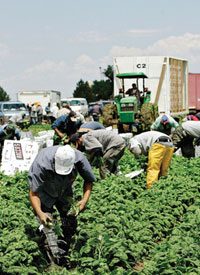
Two persistent myths peddled by the open-borders lobby about illegal aliens are that they do not harm the wages or American workers, and even if they do, illegals in particular and immigrants in general do the jobs that Americans won’t do.
Four years ago, economist George Borjas of Harvard University conducted a study for Maricopa County, Arizona. He found that illegal aliens alone depressed wages in Arizona by $1.4 billion in 2006, and knocked 4.2 percent off the wages of low-skilled workers. According the Phoenix Business Journal, Borjas calculated “that illegals make up 10 percent of all state workers and decrease all wages by 1.5 percent.”
Those findings are consistent with what Borjas reported for the Center for Immigration Studies in 2004.
Between 1980 and 2000, Borjas wrote for the CIS, immigrants reduced the average wage of American workers by four percent, or $1,700 per worker. And “among natives without a high school education, who roughly correspond to the poorest tenth of the workforce, the estimated impact was even larger, reducing their wages by 7.4 percent.”
In 1997, working for the National Research Council, Borjas reported that immigration knocked wages down 44 percent between 1980 and 1995. In 1988, according to the New York Times, the Government Accountability Office found that “illegal aliens depress wages for some in U.S.”
This might be why Cesar Chavez, hero of the United Farm Workers, vigorously opposed illegal immigration and even sent goon squads to the border to stop illegals from entering the country. He accused the Immigration and Naturalization Service, forerunner of today’s Immigration and Customs Control, of turning a blind eye to illegal-alien strikebreakers.
But even worse, some Americans lose their jobs to immigrants. In 1995, Donald Huddle of Rice University calculated that immigrants displaced 730,000 American workers annually, at a cost of $4.3 billion. A few years earlier, in The Social Contract, he wrote that his “1982 and 1985 studies of displacement in the Houston metropolitan area indicate that for every 100 illegal alien workers, 70 legal workers are displaced or not able to obtain employment.”
And again, as with the truth that immigrants depress wages, the figures on displacement do not change over time. In September, using data from the Bureau of Labor Statistics, Ed Rubenstein of VDare.com concluded that immigrants displace American workers. Over the last year, Rubenstein wrote:
Immigrant employment rose 3.3%; native-born employment fell 0.7%
Immigrant unemployment fell by 8.9%; native-born unemployment rose 1.3%
The immigrant unemployment rate (unemployment relative to workforce) declined by 10.9%; the native-born unemployment rate rose 1.1%. As a result:
The native-born and immigrants switched places: last August, the native-born unemployment rate was 0.6 percentage points below that of immigrants; this August, the native-born rate was 0.6 percentage points above the immigrant rate.
The second myth is that immigrants “do the jobs Americans won’t do.” The open-borders crowd avers that fruit would go unpicked, homes uncleaned, and buildings unbuilt without illegal-alien or immigrant labor. In a word, hooey.
CIS studied Census data in 2009 and found that of nearly 500 civilian occupations, “only four are majority immigrant” and “account for less than 1 percent of the total U.S. workforce. Moreover, native-born Americans comprise 47 percent of workers in these occupations.”
As CIS reported, “Many jobs often thought to be overwhelmingly immigrant are in fact majority native-born:”
Maids and housekeepers: 55 percent native-born
Taxi drivers and chauffeurs: 58 percent native-born
Butchers and meat processors: 63 percent native-born
Grounds maintenance workers: 65 percent native-born
Construction laborers: 65 percent native-born
Porters, bellhops, and concierges: 71 percent native-born
Janitors: 75 percent native-born
The data from Rubenstein on rising and falling unemployment vis-à-vis immigrants vs. Americans suggest that illegals wouldn’t have the jobs they do and Americans would still be doing them if the borders were secure.
— Photo: AP Images
Related article:


